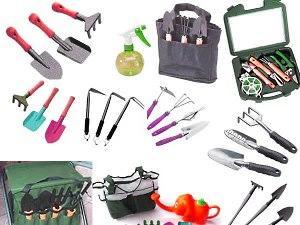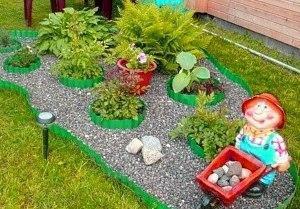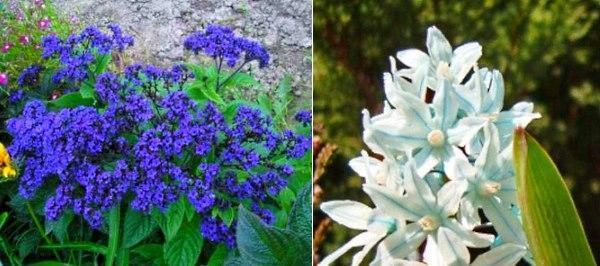Floriculture in the country for beginners or how to beautifully decorate a summer cottage
 Many people plant their beds with anything. Later, they face problems such as overgrowth of shrubs and flowers, not a combination of colors flower beds, lack of lawn, the need for additional track, the employment of the garden space. And it's a pity to throw away the flowers. And often there is no one to give. What is left? There is only one way out - to plan in advance the design of the future flower garden.
Many people plant their beds with anything. Later, they face problems such as overgrowth of shrubs and flowers, not a combination of colors flower beds, lack of lawn, the need for additional track, the employment of the garden space. And it's a pity to throw away the flowers. And often there is no one to give. What is left? There is only one way out - to plan in advance the design of the future flower garden.
Gradually mastering floriculture in the country, beginners should know before planning:
- varieties of flowering plants;
- the location of the future flower garden;
- necessary tools and devices that may be needed in the process of work;
- methods of grouping plants.
It is very important that the flower bed looks natural and is a single whole, and not a collection of separate flower beds.
Ten basic rules of floriculture in the country for beginners
- Never over-water it.
Roots need not only water, but also air. Proper watering promotes soil moisture. Keep in mind that intensive watering is death for some plant species. - Observe winter rest.
Plants need rest in winter. During this period, they do not need watering and feeding. - Do not be sad about the death of some plants.
Flowers such as peonies, daffodils, tulips, chrysanthemums, roses are dug in for the winter, covered with fallen leaves and wood sawdust, providing conditions for a favorable winter. But there are times when severe frosts do not save the plants from the cold, their roots freeze, leading to the death of some species. Do not be sad about plant losses. It's not your fault. Literally all types of these plants (if they are healthy, of course) are frost-resistant and must adapt to unfavorable weather conditions. - Maintain a humid atmosphere.
Monitor the humidity of the air. On hot days, water the plants abundantly in the early morning and evening. Plant flowers taking into account the peculiarities of their content. Plant heat-loving plants in the sun, shade-loving plants in the shade. You can increase the moisture content of plants that do not like water very much by spraying or feeding with wet peat. - Take the necessary measures in time.
Trouble happens to both skilled growers and beginners. Small pests are easy to kill as soon as they appear. Otherwise, it will be much more difficult to deal with them. Learn to spot the signs of plant disease in time. - Plant plants in groups.
Always plant in groups. So they will not only look better, but also require the same care conditions, which will greatly simplify their care. - Master transplant technology.
Typically, one to two years after planting, many plants become less attractive. In such cases, it is enough to transplant them, feed them, or simply plant them. - Choose plants taking into account the conditions of their maintenance.
Each plant develops in a suitable environment. Florists provide them with these conditions. Sometimes there are times when beginners cannot grow a shade-loving plant in the sun. - Purchase the necessary inventory.
According to floriculture in the country for beginners, a beginner grower should always have: fertilizers, pots for plant transplantation, a watering can, suitable soil, sprayer, props and ropes, pest control products, shovel, old spoons and forks, soft sponge, sand, pebbles. - Learn how to properly care for various plants.
Proper care provides excellent conditions for the development of plants, stimulating their growth.
What plants are suitable for gardening in the country?

Experienced gardeners perennial plants grow well.
Novice flower growers sometimes get lost among the abundance of various bags with flower seeds on store shelves. Questions often come to their minds: "What plants to choose for planting in a summer cottage?", "How to care for them?", "How to create favorable conditions for the development of flowers?"
Adhering to simple recommendations, you can easily master floriculture in the country.
Annual plants are good because they abundantly delight with their flowering, are planted annually, which means that if the plant did not suit your taste, you can not plant it next year.
With perennials, everything is different. They quickly take root, they cannot be thrown away just like that, they are frost-resistant, not painful. When choosing which flowers to plant, take into account the composition and quality of the soil at the summer cottage, as well as the illumination of the land. For example, if the soil is sandy at the dacha, clarkia and dimorphoteka will take root there, if it is highly moistened, choose mignonette, marigold, morning glory, marigold (calendula). On alkaline soil you will be delighted with nasturtium, levkoy, tobacco, poppy, petunia... These plants are perfect for planting near curbs.
If a plant doesn't live for more than two or three years, do not be sad. So it doesn't suit you. Don't plant it anymore. It is better to pick up some other varieties that will be more comfortable on your site.
How to plan a flower bed for a novice gardener?
When planning a flower bed in a summer cottage, it is important to consider the following points:
- Absolutely all plants turn their flowers towards the sun. To avoid "turned away" flowers, you should equip the flower bed on the south side.
- When the flower bed is located near fence keep in mind that the plants will be visible not only to you, but also to passers-by.
- When sowing flowers in a flower bed, leave space between groups of plants. Better to let the flowerbed look free than the spreading flowers will cover their fellows.
- When planning a flower bed, always consider the variety of plants, their height and the conditions of care. Also, keep the distance between flowers of the same species. Too thick seedlings of flowers after sowing can be carefully dug up and transplanted to another place. Always consider the tendency of plants to transplant and choose the most favorable period for this.
- If you come up with an idea to collect seeds of certain varieties of flowers, do it in advance, without putting it in a long box, because the following weekend, the plant may bloom and disperse seeds, or merge in a flower garden with its brothers.
- To plants (like annual, and perennials) delighted with their flowering for a long time, you should periodically cut off faded buds, fruits and ovaries. This accelerates the growth of flowers and stimulates the re-flowering of most plants. For example, lupine, delphinium, Turkish carnations are best cut after all faded flowers have wither. After pruning, the plants will delight you with repeated flowering again.
- Do not plant the same type of plants in the entire flower bed. When the flowers have faded, the area will be empty and look unsightly.
- There are plants that close in cloudy and rainy weather. Consider this detail when planning gardening for your summer cottage.
- Make it a rule to plant bulbs next to perennials with strong foliage. In the spring, until perennials have spread their foliage, bulbous plants will show themselves in all their glory, then, perennials will cover drying faded plants with foliage, which will preserve the beauty and design of the flower bed.
- Starting this summer, think over site design next year. Perhaps you like the neighbors' flowers and want to plant the same next spring. Find out the varieties, conditions of care, the cost of flowers. Perhaps the neighbors will gladly exchange some types of plants with you.
How to create a continuous flowering flower bed?
A continuous blooming effect can be achieved by planting annual and perennial flowers at the same time. In this case, flowering will be ensured from April-May until the first frost.
Perennial plants have several benefits. This is a one-time disembarkation, easy care, easy transplant, adaptation to the conditions of detention, frost resistance.
Among perennial plants, irises and lupins, picky Turkish carnations, lychnis, foxglove, eschsholzia, dahlias, gladioli, lilies, echinacea, cornflower, crocuses, hyacinths, astilba, Gaillardia, hazelnuts, bushes, muscarias , iris, daylily, heuchera, daffodils, blueberry, chionodox, fern, hosta, peony. Remember that gladioli and dahlias should be dug up for the winter, because they are afraid of severe frosts. The rest of the plants do not require transplantation.
27 unpretentious flowers for floriculture in the country
To make a beautiful garden plot, novice flower growers invest a lot of effort, money and time to create original flower beds. Most people dream of decorating their summer cottage with unpretentious plant species that are not demanding on watering, care, climate, but not everyone succeeds the first time. You can choose the right flowers by studying floriculture in the country, taking into account the peculiarities of the location of the site and the seasonal decorativeness of the desired flower garden.
Among the bulbous plants, the most loved by flower growers:
- iridodictiums;
- muscari;
- daffodils;
- botanical tulips;
- chionodox;
- colchicum;
- crocuses;
- Pushkinia.

More experienced flower growers advise planting summer cottages with flowering perennials, including:
- aquilegia;
- astilba.
Having picked up flowers of various colors, having different flowering periods and textures, you can create an original flower garden from the astilbes themselves. More details about the nuances of planting and caring for astilbe can be found by reading the articles on "Floriculture in the country for beginners."
- loosestrife;
- periwinkle;
- meadowsweet;
- evening primrose;
- perennial cornflower;
- swimsuit;
- geranium;
- small petals;
- doronicum;
- brunner;
- bought;
- spurge;
- lupine;
- lungwort;
- goldenrod;
- catnip.

Very loved by gardeners for their unpretentiousness, simplicity and care in growing such annual and biennial flowers, such as:
- forget-me-nots;
- calendula;
- viola;
- phacelia;
- linen;
- marigold;
- cornflowers;
- Turkish carnation;
- daisies;
- nasturtium.

As you can see, there are a lot of plants designed to create beautiful flower beds in summer cottages. The list of plants can be supplemented with more and more new types of flowers. The whole difficulty lies only in the desire to create something beautiful and unique, with the effort and time.
We have had a summer cottage for a long time, but I have never seriously thought about creating a flower bed. Although, of course, there are flowers for me, but they are scattered throughout the garden and vegetable garden. I plant calendula in the garden, tulips grow randomly near the house, there are several peonies, I planted a rose this summer and it started. And now I think that we really need to think over a flower bed of continuous flowering.